In today’s rapidly evolving business landscape, unforeseen disasters can strike at any moment, threatening to disrupt operations, cripple productivity, and jeopardize your bottom line. From natural calamities like earthquakes and floods to cyberattacks and data breaches, the potential for unexpected disruptions is ever-present. As a forward-thinking business owner, safeguarding your organization against such calamities is paramount. This is where comprehensive disaster recovery solutions come into play, providing a robust shield to protect your business from the unexpected and ensure continuity of operations.
A comprehensive disaster recovery plan is not just a reactive measure; it is a proactive strategy that empowers businesses to navigate challenges with resilience and agility. It encompasses a wide range of solutions, including data backup and recovery, business continuity planning, disaster recovery testing, and security measures. By implementing these strategies, businesses can minimize downtime, protect critical data, and maintain operational efficiency even in the face of adversity.
Understanding Disaster Recovery (DR)
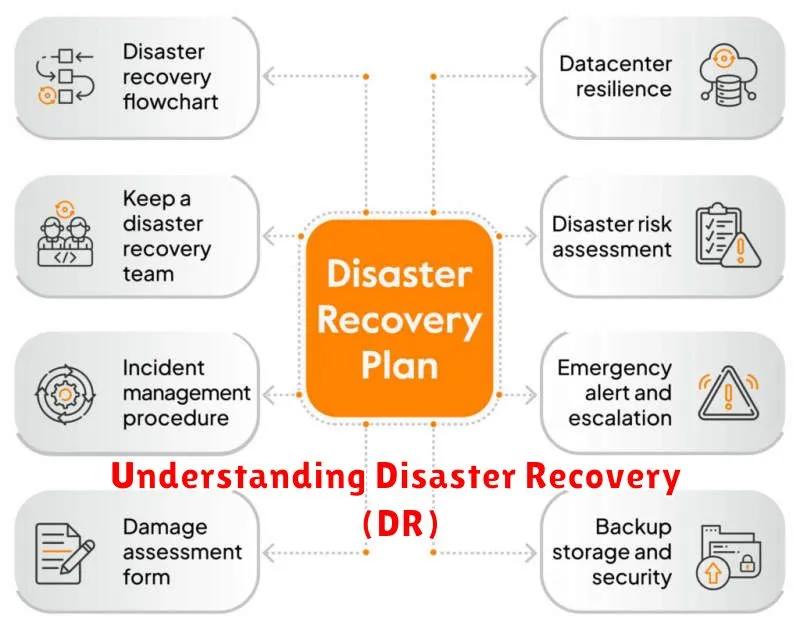
Disaster recovery (DR) is a critical aspect of business continuity planning that ensures your organization can recover from unexpected events and continue operating. These events can range from natural disasters like floods and earthquakes to man-made incidents like fires, cyberattacks, or power outages.
A comprehensive DR plan outlines steps to minimize downtime, protect data, and restore critical systems and applications. It involves identifying potential threats, assessing their impact, and developing strategies for mitigating risks.
Key elements of a robust DR plan include:
- Data Backup and Recovery: Ensuring that critical data is regularly backed up and can be restored quickly in case of data loss.
- Business Continuity Plan: Defining essential business processes and alternative procedures for maintaining operations during a disruption.
- Recovery Site: Establishing a secondary location with infrastructure and resources for system and application recovery.
- Communication Plan: Establishing clear communication channels for notifying employees, customers, and stakeholders during an incident.
- Testing and Training: Regularly testing DR plans and training staff to ensure readiness and effectiveness.
Implementing a DR strategy helps businesses to:
- Minimize downtime and financial losses: By quickly restoring operations, businesses can reduce revenue disruption and minimize operational costs.
- Protect critical data and systems: DR safeguards against data loss and ensures business continuity through data backup and recovery solutions.
- Maintain customer relationships: By minimizing service interruptions, businesses can maintain customer satisfaction and loyalty.
- Enhance business resilience: A well-defined DR plan strengthens business resilience and prepares organizations for unforeseen challenges.
Understanding disaster recovery is essential for every business seeking to safeguard its operations and ensure long-term sustainability. By investing in a comprehensive DR strategy, organizations can mitigate risks, minimize disruption, and protect their future.
Types of Disasters and Their Impact
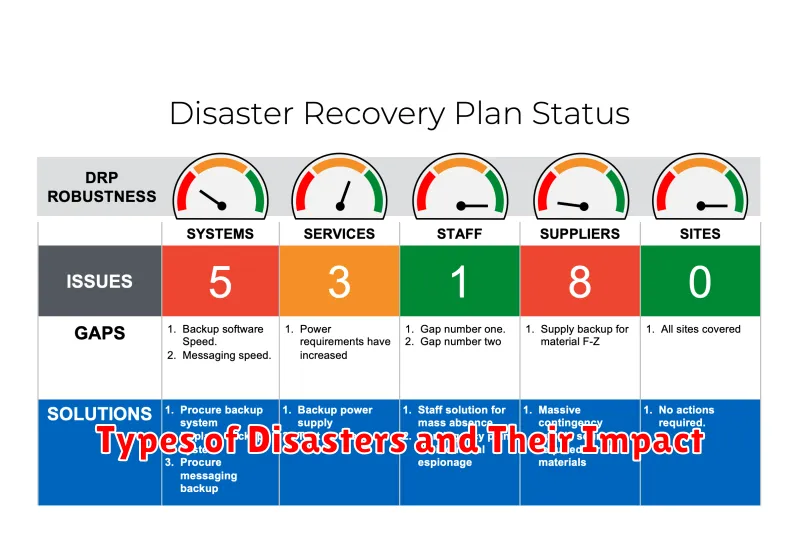
Disasters can strike at any time, causing significant disruption to businesses and impacting their operations, finances, and reputation. Understanding the different types of disasters and their potential impact is crucial for developing effective disaster recovery strategies.
Natural Disasters: These are unpredictable events caused by natural forces, such as earthquakes, hurricanes, floods, tornadoes, wildfires, and volcanic eruptions. They can cause widespread damage to infrastructure, property, and equipment, leading to business interruptions, supply chain disruptions, and financial losses.
Man-Made Disasters: These are events caused by human actions, including accidents, terrorism, cyberattacks, and technological failures. These disasters can result in data breaches, system outages, reputational damage, and financial losses.
Technological Disasters: These events involve failures in technological systems, such as software glitches, hardware malfunctions, power outages, and network disruptions. They can lead to data loss, system downtime, and operational inefficiencies.
Economic Disasters: These events are related to financial crises, such as recessions, market crashes, and currency fluctuations. They can impact business revenue, profitability, and overall economic stability.
The impact of disasters can vary depending on the type, severity, and the industry affected. However, common consequences include:
- Business Interruption: Disasters can force businesses to shut down operations temporarily or permanently, leading to lost revenue and productivity.
- Data Loss: Critical data stored on physical or digital devices can be lost or corrupted, hindering business operations and decision-making.
- Property Damage: Buildings, equipment, and infrastructure can be damaged or destroyed, resulting in significant repair or replacement costs.
- Financial Losses: Disasters can lead to substantial financial losses, including lost revenue, property damage costs, and legal expenses.
- Reputational Damage: Disasters can negatively impact a company’s reputation, leading to customer dissatisfaction, reduced trust, and lost market share.
To minimize the impact of disasters, businesses must proactively prepare and implement comprehensive disaster recovery plans. This includes identifying potential risks, establishing backup and recovery procedures, and training employees on disaster response protocols.
Key Components of a Disaster Recovery Plan
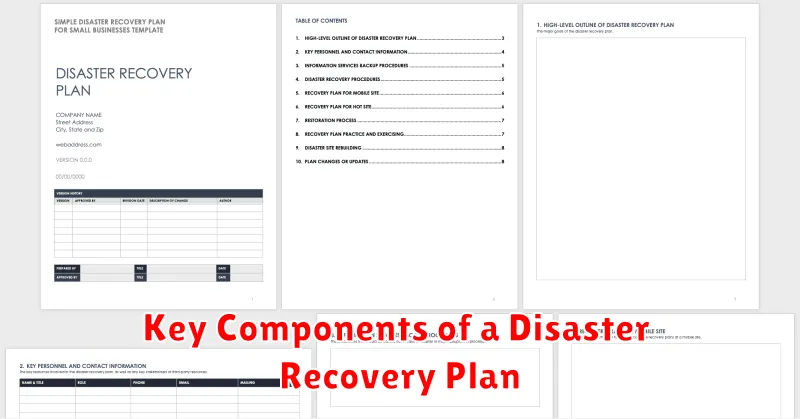
A comprehensive disaster recovery plan is essential for any business seeking to mitigate the impact of unexpected events. Such a plan outlines the steps necessary to restore critical business functions and minimize downtime in the face of disruptions. A well-structured plan encompasses several key components:
1. Business Impact Analysis
This critical step involves identifying and prioritizing critical business functions. It assesses the potential impact of various disasters on these functions, determining the acceptable downtime for each. This analysis helps determine the recovery time objectives (RTOs) and recovery point objectives (RPOs) for different systems and data.
2. Risk Assessment
A thorough risk assessment identifies potential threats that could disrupt operations. This includes natural disasters, technological failures, human errors, cyberattacks, and other unforeseen circumstances. The assessment prioritizes risks based on their likelihood and potential impact, guiding the development of mitigation strategies.
3. Recovery Strategies
Based on the business impact analysis and risk assessment, the plan outlines recovery strategies for various scenarios. These strategies may include:
- Data backup and recovery: Defining procedures for regular data backups and ensuring their integrity and accessibility.
- Redundant systems and infrastructure: Implementing failover systems and redundant infrastructure to maintain operations during outages.
- Offsite data storage and recovery: Utilizing secure offsite data storage for disaster recovery purposes.
- Business continuity plan: Establishing procedures for maintaining essential business functions during disruptions.
- Communication plan: Defining communication channels and protocols for internal and external stakeholders during a crisis.
4. Testing and Maintenance
Regular testing of the disaster recovery plan is crucial to ensure its effectiveness. Simulated disaster scenarios help identify weaknesses and areas for improvement. The plan should also be reviewed and updated periodically to reflect changes in business operations and evolving threats.
5. Training and Awareness
Training employees on their roles and responsibilities during a disaster is essential for a smooth recovery. Regular drills and simulations help familiarize staff with the plan and build confidence in their ability to execute it effectively.
By incorporating these key components, businesses can develop a comprehensive and robust disaster recovery plan that provides the necessary resilience to withstand unforeseen challenges and protect their critical assets.
Data Backup and Recovery

In the dynamic business landscape, unforeseen events like natural disasters, cyberattacks, or hardware failures can strike at any moment, potentially crippling your operations and jeopardizing your valuable data. Data backup and recovery are essential components of a comprehensive disaster recovery plan, providing a lifeline for businesses to weather these storms and emerge resilient.
Data backup involves creating duplicate copies of your critical data and storing them securely offsite. This ensures that even if your primary data source is lost or compromised, you have a readily available backup to restore your systems and resume operations. Data recovery, on the other hand, focuses on retrieving lost or corrupted data from backup copies, minimizing downtime and data loss.
Here are some key aspects of data backup and recovery that businesses should consider:
- Types of Backup Solutions: From traditional tape backups to cloud-based solutions, there are numerous options available, each with its pros and cons. Selecting the right solution depends on your specific needs, data volume, budget, and recovery time objectives (RTOs).
- Data Backup Frequency: Regular backups are crucial. The frequency of backups should align with the criticality of your data and the rate of change in your systems. Frequent backups minimize data loss in case of an event.
- Backup Storage Location: Storing backups offsite ensures protection against local disasters or physical damage to your primary data center. Cloud storage, geographically dispersed data centers, or secure vault facilities are common options.
- Data Recovery Testing: Regularly testing your backup and recovery processes ensures they are functioning as expected and that you can restore data successfully. This is essential for verifying the effectiveness of your plan.
By implementing robust data backup and recovery strategies, businesses can minimize the impact of unforeseen events, protect their valuable data, and ensure business continuity. Investing in these solutions demonstrates a commitment to resilience, enabling your organization to weather any storm and emerge stronger than before.
Business Continuity Planning (BCP)
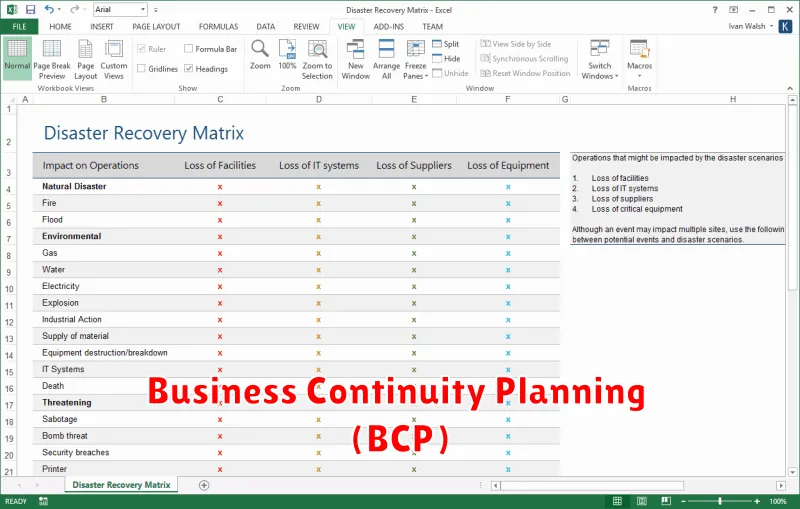
A comprehensive Business Continuity Plan (BCP) is crucial for any organization that wants to shield itself from the unexpected. This plan outlines strategies and procedures to ensure continued operations in the event of a disaster or disruption. It’s a proactive approach that helps businesses minimize downtime, protect vital data, and maintain customer satisfaction even in the face of unforeseen challenges.
A well-crafted BCP should address a wide range of potential disruptions, from natural disasters and cyberattacks to power outages and equipment failures. It should clearly define critical business processes, identify key resources, and establish recovery time objectives (RTOs) and recovery point objectives (RPOs).
The core elements of a robust BCP include:
- Risk Assessment: Identifying and analyzing potential threats to your business.
- Business Impact Analysis (BIA): Determining the impact of disruptions on critical business functions.
- Recovery Strategies: Developing plans for restoring operations and data after an incident.
- Communication Plan: Establishing clear communication channels for stakeholders during and after a disruption.
- Testing and Training: Regularly testing and reviewing the BCP to ensure its effectiveness.
By implementing a comprehensive BCP, businesses can significantly reduce their vulnerability to disruptions. It empowers them to respond effectively to challenges, minimize financial losses, and maintain their competitive edge.
Disaster Recovery as a Service (DRaaS)
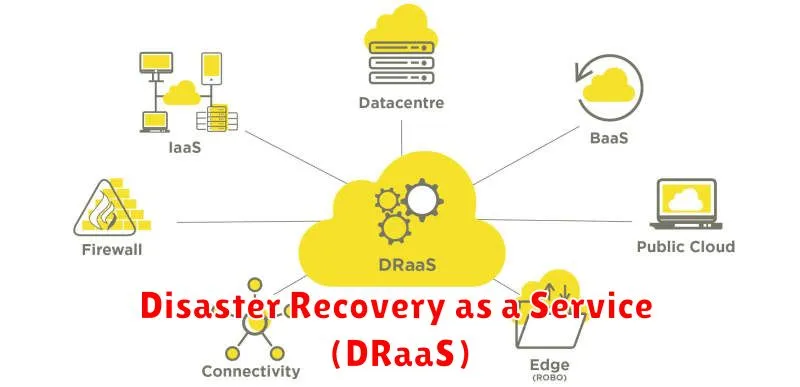
In today’s digital landscape, businesses are increasingly reliant on technology. This dependence, while beneficial, also makes them vulnerable to disruptions caused by natural disasters, cyberattacks, or other unforeseen events. Disaster Recovery as a Service (DRaaS) emerges as a crucial solution to safeguard your business operations and ensure continuity in the face of adversity.
DRaaS is a cloud-based service that provides a comprehensive disaster recovery plan, enabling businesses to quickly recover their critical IT infrastructure and applications in the event of a disaster. This service effectively mitigates downtime and data loss, minimizing disruption to your business operations.
Here’s how DRaaS works: your business data and applications are replicated and stored securely in a cloud environment. In case of a disaster, you can seamlessly switch over to this backup environment, restoring access to your critical systems and data within minutes or hours, instead of days or weeks.
The benefits of DRaaS are numerous:
- Reduced downtime and data loss: DRaaS ensures quick recovery, minimizing the impact on your business operations and customer experience.
- Cost-effectiveness: DRaaS eliminates the need for expensive on-premise infrastructure and dedicated IT personnel, offering a cost-effective solution.
- Scalability and flexibility: DRaaS is scalable, allowing you to adjust your recovery plan based on your specific needs and business growth.
- Enhanced security: Cloud providers implement robust security measures to safeguard your data and infrastructure.
- Ease of management: DRaaS is managed by the cloud provider, simplifying your disaster recovery planning and execution.
DRaaS is an essential component of any comprehensive disaster recovery strategy. By leveraging this service, businesses can fortify their resilience against unforeseen events, ensuring continued operations and minimizing potential losses. As you navigate the complexities of today’s business environment, investing in DRaaS is a wise decision that can safeguard your future.
Cloud-Based Disaster Recovery
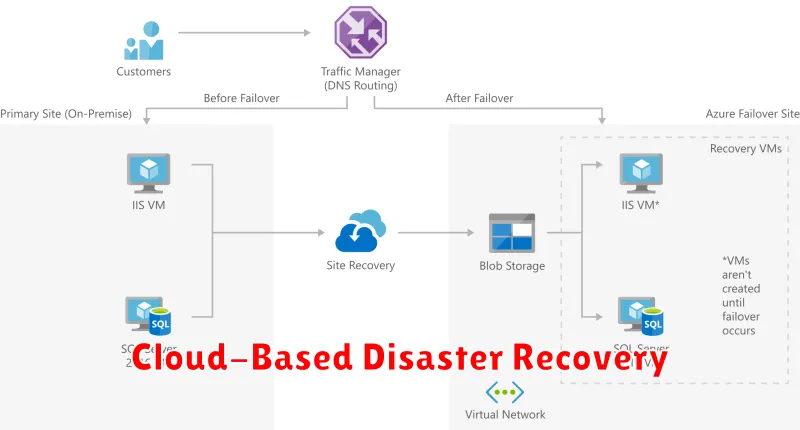
In today’s digitally driven world, businesses face a myriad of challenges, including the ever-present threat of disasters. From natural calamities to cyberattacks, the potential for disruption is real and can have devastating consequences. A robust disaster recovery plan is essential to ensure business continuity and minimize downtime in the face of adversity. Enter cloud-based disaster recovery, a game-changer for businesses seeking comprehensive and reliable protection.
Cloud-based disaster recovery leverages the power of cloud computing to create a virtual replica of your critical data and applications. This replica is hosted in a remote data center, physically distanced from your primary location. In the event of a disaster, your business can seamlessly transition to this cloud environment, ensuring uninterrupted operations.
Here are some key advantages of cloud-based disaster recovery:
- Cost-effectiveness: Cloud solutions eliminate the need for expensive on-premises infrastructure and maintenance, making them an attractive option for businesses of all sizes.
- Scalability and Flexibility: Cloud-based disaster recovery solutions can be easily scaled up or down to meet changing business needs. You only pay for what you use, ensuring optimal resource utilization.
- Enhanced Security: Reputable cloud providers offer robust security measures, safeguarding your data from unauthorized access and cyber threats.
- Rapid Recovery: Cloud-based solutions enable faster recovery times, minimizing downtime and business disruption.
- Accessibility: With cloud-based disaster recovery, you can access your data and applications from anywhere with an internet connection.
By embracing cloud-based disaster recovery, businesses can shield themselves from the unexpected and ensure continued operations, regardless of unforeseen circumstances. It’s a proactive approach to risk management that provides peace of mind and protects your bottom line.
Testing and Maintaining Your DR Plan

A disaster recovery (DR) plan is essential for any business, as it outlines the steps to be taken in the event of a disaster that could disrupt operations. However, a DR plan is only as good as its implementation. Regular testing and maintenance are crucial to ensure that your plan is up-to-date, effective, and ready to be executed when needed.
Testing your DR plan involves simulating a disaster scenario and evaluating your organization’s response. This helps to identify weaknesses in your plan and to train your team on how to execute it. There are different types of testing, ranging from tabletop exercises to full-scale simulations. The type of test you choose should depend on your organization’s specific needs and resources.
Maintaining your DR plan involves keeping it up-to-date with any changes to your business or environment. This includes updating contact information, revising recovery procedures, and adding new technology or applications. It’s also essential to review your plan regularly, especially after any significant changes or incidents, and make necessary adjustments.
Key benefits of testing and maintaining your DR plan include:
- Improved preparedness: Regular testing helps your team be more prepared to respond to a disaster.
- Reduced downtime: A well-tested and maintained DR plan helps to minimize the downtime your business experiences in the event of a disaster.
- Enhanced data security: Testing your DR plan ensures that your data recovery procedures are effective and secure.
- Increased confidence: Knowing that your DR plan is up-to-date and tested gives you confidence in your organization’s ability to recover from a disaster.
In conclusion, testing and maintaining your DR plan is vital to its success. By regularly evaluating and updating your plan, you can ensure that it is effective and ready to help your business recover from any unexpected event.
Disaster Recovery Best Practices
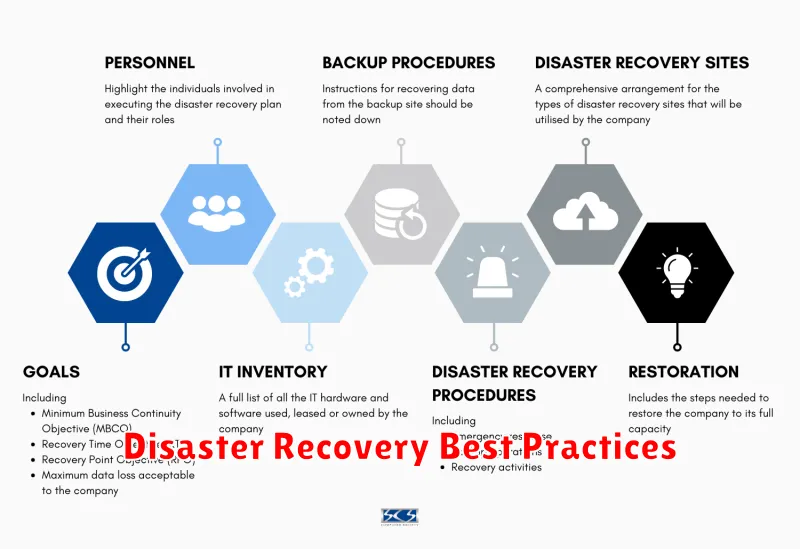
In today’s interconnected world, businesses are increasingly vulnerable to disruptions caused by natural disasters, cyberattacks, and other unforeseen events. A robust disaster recovery plan is essential to minimize downtime, protect critical data, and ensure business continuity. By implementing the following best practices, you can effectively shield your business from the unexpected.
1. Conduct a Risk Assessment: The first step is to identify and assess potential threats that could impact your operations. This includes natural disasters, cyberattacks, equipment failure, and human error. A comprehensive risk assessment will help you prioritize your disaster recovery efforts and allocate resources effectively.
2. Define Recovery Time Objectives (RTO) and Recovery Point Objectives (RPO): These metrics are crucial for determining your recovery goals. RTO defines the maximum acceptable downtime for your critical systems, while RPO specifies the maximum amount of data loss that your organization can tolerate. Clearly defined RTOs and RPOs ensure that you have a realistic and achievable recovery plan.
3. Implement Data Backup and Recovery Strategies: Data is the lifeblood of any business, so it’s essential to have a secure and reliable backup and recovery system. Consider both on-site and off-site backups, as well as cloud-based solutions. Regular testing of backups is vital to ensure their integrity and functionality.
4. Establish a Communication Plan: In the event of a disaster, clear and concise communication is paramount. Develop a communication plan that outlines roles and responsibilities, contact information, and escalation procedures. This plan should be communicated to all employees and stakeholders.
5. Conduct Regular Disaster Recovery Drills: Simulated disaster scenarios allow you to test your plan and identify areas for improvement. Drills should be conducted regularly, involving all key personnel, to ensure that your team is familiar with the procedures and can respond effectively in a real-world event.
6. Secure Your Infrastructure: Invest in physical and digital security measures to protect your critical infrastructure from threats. This includes physical security for data centers, network security, and access controls. Regular security audits and updates are essential to mitigate vulnerabilities.
7. Embrace Cloud Solutions: Cloud computing provides a scalable and resilient platform for disaster recovery. Cloud-based services like disaster recovery as a service (DRaaS) can help you quickly restore data and applications in the event of a disaster, minimizing downtime and operational disruption.
By implementing these best practices, you can build a robust disaster recovery plan that protects your business from unforeseen events. Remember that a proactive approach is essential to ensure business continuity and resilience in today’s volatile landscape.

